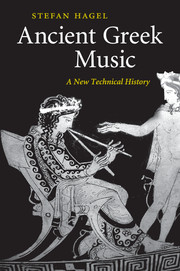Book contents
- Frontmatter
- Contents
- List of diagrams
- List of tables
- List of figures
- List of abbreviations
- Preface
- 1 The evolution of ancient Greek musical notation
- 2 Notation, instruments and the voice
- 3 Notation in the handbooks
- 4 Strings and notes
- 5 Fine tuning
- 6 Going beyond Ptolemy?
- 7 Assisted resonance
- 8 The extant musical documents
- 9 Aulos types and pitches
- 10 Before Aristoxenus
- 11 Synthesis
- Bibliography
- Indices
7 - Assisted resonance
Published online by Cambridge University Press: 03 May 2010
- Frontmatter
- Contents
- List of diagrams
- List of tables
- List of figures
- List of abbreviations
- Preface
- 1 The evolution of ancient Greek musical notation
- 2 Notation, instruments and the voice
- 3 Notation in the handbooks
- 4 Strings and notes
- 5 Fine tuning
- 6 Going beyond Ptolemy?
- 7 Assisted resonance
- 8 The extant musical documents
- 9 Aulos types and pitches
- 10 Before Aristoxenus
- 11 Synthesis
- Bibliography
- Indices
Summary
THE RESONATORS DESCRIBED BY VITRUVIUS
According to the Roman author Vitruvius, many Greek stone theatres of his time were equipped with sets of tuned resonating jars, distributed in semicircles around the auditorium, which reinforced certain pitches (wooden theatre constructions as common in Rome, we are told, would not require such resonators, thanks to the elasticity of the material). Smaller auditoria had only one row, which merely emphasised the harmonic framework; in larger ones, two further rows introduced the chromatic and diatonic likhanoí (cf. Diagram 70). Vitruvius gives all the details within the terminology of the Perfect System, without specifying a particular tónos. It goes without saying that the resonators were of fixed pitch and would not be changed for pieces in various keys. Consequently we are to understand Vitruvius' note names in terms of the ‘natural’ tónos, the Lydian, in the manner that we know from Ptolemy and the hormasía.
Of the three rows, the first is associated with ‘harmonia’. By opposition to a chromatic and the diatonic row, we would expect that this term implies the enharmonic genus. Yet the resonators in question hold neither quartertones nor major thirds, but the ‘fixed’ notes of the Perfect System, including nḗtē synēmménōn (d), but not the proslambanómenos (A). Thus, the paramount notes of the citharodic octave, primarily its ‘harmonía’ e – a – b – e’, are supplemented by the fourths below, the fourth above, and those from mésē upwards.
- Type
- Chapter
- Information
- Ancient Greek MusicA New Technical History, pp. 251 - 255Publisher: Cambridge University PressPrint publication year: 2009



